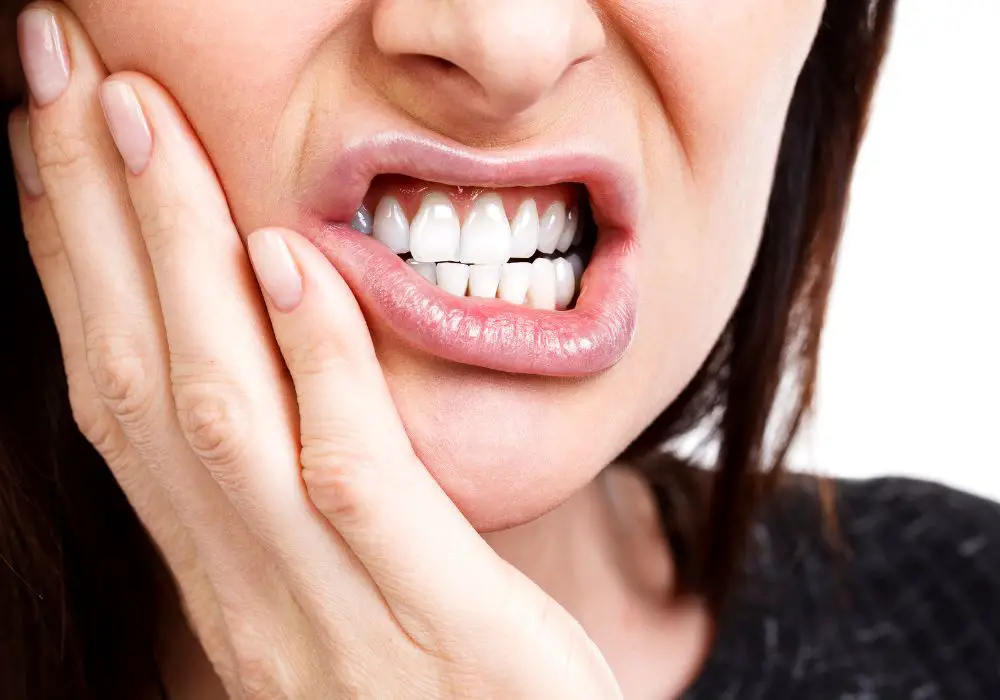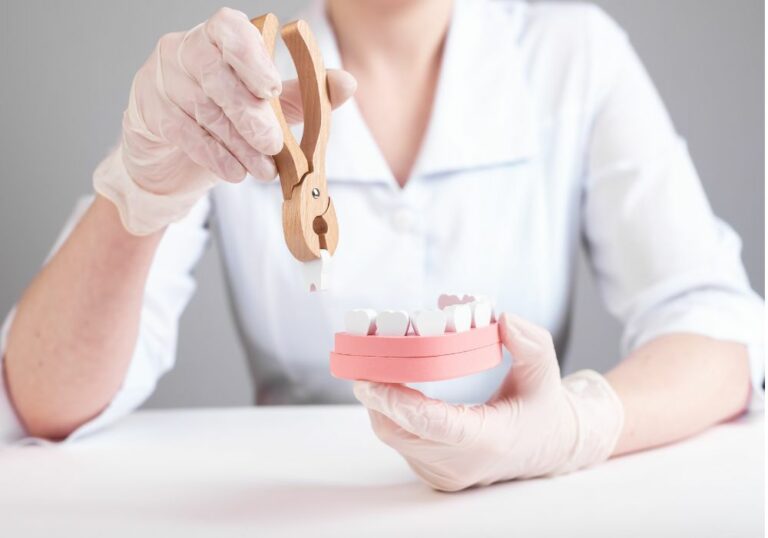A dull, throbbing toothache can indicate several different underlying dental problems. While the pain is often mild at first, leaving it untreated allows the condition to worsen over time. Getting an accurate diagnosis and prompt treatment is key to resolving the toothache and preventing complications.
What’s causing the dull pain?
There are a number of possible causes for a dull toothache:
1. Tooth decay
Tooth decay, or cavities, are a very common source of dull tooth pain. Plaque, a sticky film of bacteria, accumulates on tooth surfaces, especially in hard-to-clean areas. The bacteria metabolize sugars and carbs into acids, which decalcify and dissolve the enamel. This causes a cavity to form. A cavity may not produce any symptoms initially. But as it grows larger and deeper into dentin and gets closer to the pulp, it often triggers a dull ache. The pain tends to be intermittent, coming and going in response to hot or cold foods and drinks.
As decay reaches the inner pulp chamber, the ache becomes more constant and lingering. The exposed nerves in the pulp become inflamed and hypersensitive. Pulpitis, or inflammation of the pulp, occurs. This intensifies the dull pain. The ache may radiate to the ear, jaw, and side of the face. It can keep you up at night or require pain medication to manage.
Without treatment, extensive decay leads to death of the tooth’s pulp tissue. An abscess may form at the tip of the tooth root, causing throbbing pain and swelling. Tooth decay requires prompt filling to remove the decayed material and prevent abscess and tooth loss.
2. Cracked or broken tooth
Chewing on something hard like popcorn kernels, candy, or ice can cause tiny cracks or fractures in the enamel. Extreme temperature changes, like drinking hot coffee after chewing ice, may also cause teeth to crack. The crack exposes the inner dentin and pulp to bacteria, air, and fluids. This irritation triggers inflammation in the pulp that manifests as a mild, dull ache.
Cracked tooth syndrome involves pain with chewing pressure that comes and goes. The discomfort may be sharp initially and then settle into a dull ache. As the crack propagates deeper into the tooth over weeks and months, the pain often intensifies. Eventually, the fracture may split the tooth completely in two.
Biting down reveals the crack’s location. Dental x-rays may be needed to visualize the fracture line. Prompt treatment with crowns, capping, or root canals can save the fractured tooth and relieve symptoms. Extracting the tooth may be required if the crack is extensive.
3. Dental pulp inflammation
The dental pulp contains sensitive nerves, blood vessels, and connective tissue. It can become inflamed for a number of reasons:
- Extensive decay – Bacteria and acids from cavities irritating the pulp chamber
- Cracked tooth – Fractures allowing bacteria to invade the pulp
- Recent dental procedures – Drilling trauma during fillings, crowns, etc.
- Past trauma – Injuries that bruised or concussed the tooth
- Teeth grinding – Chronic stress on the teeth wearing down enamel
Whatever the cause, pulp inflammation increases pressure inside the tooth. This manifests as a prolonged dull, throbbing ache. The pain lingers and pulsates even after hot or cold stimulation is removed. It may disturb sleep and require analgesics to control.
If the pulp is dying or necrotic, a pus-filled abscess may form on the root. This causes severe constant pain, tooth sensitivity, swelling, and bad breath. Root canal treatment or extraction is needed to resolve the infected pulp.
4. Gum disease
Periodontal disease, also called gum disease, develops when plaque on the teeth hardens into tartar that can’t be brushed away. The tartar accumulates below and between the gumline, causing gingivitis. The gums become inflamed, swollen, and prone to bleeding.
In advanced gum disease, the inflammation and bacteria destroy the ligaments and bone holding the teeth in place. The gums detach from the teeth, forming deep infected pockets. Pus may discharge from the gums. This creates gaps that allow more bacteria to invade the roots and pulp tissue. The progression of gum disease leads to dull, chronic toothache that worsens with chewing or temperature changes. The loose teeth may also ache.
Gum disease requires deep cleanings to remove tartar from teeth and infected gum tissue. Antibiotics or dental surgery may be needed to treat abscesses and regrow lost bone. Restoring gum health eliminates the constant discomfort.
When to see a dentist?

It’s important to have a dentist promptly evaluate any mysterious or persisting dull toothache. Leaving tooth decay, cracked teeth, abscesses, or gum disease untreated allows these issues to worsen over time. The sooner treatment begins, the better the outcome.
Seek emergency dental care right away if the ache:
- Is severe, constant, and not relieved by over-the-counter medication
- Radiates into your ear, sinus, neck, or side of face
- Is accompanied by facial swelling
- Disrupts sleep
- Causes difficulty eating, swallowing, or opening your mouth
- Develops after new fillings, crowns, or trauma to the mouth
Dentists have an array of diagnostic tools to identify the cause of tooth pain:
- Physical exam – Checking for cracks, decay, swelling, gum recession, loose teeth, etc.
- X-rays – Looking for hidden cavities, abscesses, or trauma. Comparing current films to past films.
- Tap test – Tapping suspect teeth to check for pain response.
- Bite test – Having you bite down on a stick to pinpoint the problem tooth.
- Cold test – Applying cold air or ice to see if it intensifies pain.
- Percussion test – Tapping the teeth to highlight pain from inflammation.
- Pulp vitality tests – Monitoring nerve response to heat, cold, and electric stimulation.
- Probing – Checking gum pockets for depth and infection.
- Palpation – Feeling for lumps, swelling, or asymmetry in face and neck.
Once the origin is identified, the dentist will recommend appropriate treatment to resolve the condition causing the ache. This may involve:
- Filling cavities
- Root canals for inflamed or dying pulp
- Tooth extractions if damage is beyond repair
- Crowns or splints for cracked teeth
- Deep cleanings, antibiotics, or surgery for gum disease
Letting a chronic dull toothache go untreated results in severe tooth damage, abscesses, tooth loss, and the spread of infection. Don’t delay diagnosis and care. See your dentist promptly for assessment and management.
When to see a doctor?
In some cases, a persistent toothache that does not respond to dental treatment may indicate a non-dental source. See a physician promptly if pain medication and dental interventions do not alleviate your symptoms. Seek medical evaluation if the ache is accompanied by:
- Swelling in the jaw, neck, or face
- Difficulty swallowing
- Numbness in the face or mouth
- An earache
- Sinus pain or headache
- Sore throat and other viral symptoms
- Fever
These signs may point to a dental abscess, sinus infection, strep throat, mononucleosis, or other medical issue requiring attention. Catching problems early prevents complications like sepsis or airway obstruction. Your doctor can order tests to diagnose the underlying problem:
- Blood tests – Signs of infection include high white blood cell and neutrophil count.
- Imaging – CT scan or MRI to detail facial anatomy and detect dental abscesses, cysts, or masses.
- Swab tests – Checking for strep throat or oral thrush.
Treatment depends on the diagnosis but may include:
- Antibiotics – Prescribed for bacterial sinusitis, oral infections, or dental abscesses.
- Drainage – Lancing and draining accumulated pus from a gum or tooth abscess.
- Medication – Corticosteroids to reduce sinus inflammation and associated pain.
- Surgery – Removing problematic teeth or other oral sources of infection.
See a physician promptly if pain persists after dental treatment. Take facial swelling, difficulty swallowing, fever, or numbness seriously.
Home remedies for temporary relief

While waiting for your dental appointment, you can try some conservative home remedies to temporarily ease dull tooth pain and swelling:
Over-the-counter pain medication
Anti-inflammatories like ibuprofen (Advil, Motrin) or naproxen (Aleve) can help reduce inflammation associated with decay or gum disease. Acetaminophen (Tylenol) blocks pain signals in the brain but does not reduce inflammation. Use as directed on the label.
Cold compression
Applying an ice pack or cold compress to the cheek and jaw near the affected tooth can alleviate pain and swelling. The cold constricts blood vessels, slowing circulation to reduce pressure, swelling, and discomfort. Use an ice pack wrapped in a thin towel for 10-20 minutes at a time, taking breaks to prevent frostbite.
Salt water rinse
Swishing warm salt water around the sore tooth may help draw out some inflammation, dislodge trapped food particles, and cleanse bacteria from the area. Dissolve 1 teaspoon salt in a cup of warm water. Rinse gently several times a day.
Clove oil
Clove oil contains eugenol, a natural anesthetic compound that briefly numbs pain. Dip a cotton swab in clove oil and gently apply to the gums around the aching tooth for temporary relief. It also has antibacterial effects to fight oral bacteria.
Soft foods
Stick to a soft food diet, avoiding hard, crunchy, chewy, or acidic items that could further irritate the damaged tooth. Foods like eggs, mashed potatoes, yogurt, cooked vegetables, and protein shakes are gentler options while awaiting dental treatment.
Dental wax
To protect a cracked or chipped tooth, cover the rough exposed surface with orthodontic wax. This creates a smooth barrier over the defect so that your tongue and food can’t irritate it. Wax may provide some temporary pain relief.
These conservative home remedies can temporarily alleviate discomfort from a mild toothache but do not treat the underlying cause. See the dentist as soon as possible for diagnosis and definitive care before the condition worsens. Leaving dental problems unchecked risks abscesses, bone and tooth loss, infection, and other complications.
What does the dentist do to treat dull toothache?

The dentist takes several steps to diagnose and resolve dull aching tooth pain:
Step 1: Examination
The dentist first thoroughly visually examines the mouth, teeth, and gums for signs of decay, cracks, swelling, loose teeth, receding gums, and asymmetry. They will probe any suspicious areas with a tool and check for texture, holes, and soft spots indicating decay.
Step 2: X-rays
Dental x-rays allow the dentist to see below the surface for cavities, cracks, bone loss, or other hidden issues. By comparing to older x-rays, the dentist can monitor changes over time. New decay appears darker in the image.
Step 3: Testing
The dentist taps lightly on teeth to check for pain response. They may apply cold air or ice to see if it causes sensitivity. Biting down on a stick localizes the problem tooth. These tests help pinpoint the cause.
Step 4: Determine treatment
Once the origin is identified, the dentist recommends appropriate treatment. For decay, they drill out cavity material and fill the hole to prevent further damage. Root canal treatment is required if the pulp is infected. Crowns and splints stabilize cracked teeth. Gum disease is treated with deep cleanings and sometimes surgery.
Step 5: Follow up
Regular dental cleanings and exams allow the dentist to monitor issues and spot new problems early. They will check healing and make sure pain has fully resolved after treatment. Follow all home care instructions to support recovery.
Do not delay seeking dental assessment and care if you have an unexplained toothache. Waiting allows minor issues to worsen into major tooth damage or systemic infection. Prompt dental treatment can resolve a variety of causes and provide lasting relief.
Frequently asked questions about dull toothaches
Why does the pain come and go?
Intermittent pain often indicates a problem in the early stages, like a new cavity just starting to reach the pulp or a slight crack slowly expanding. The pain comes from brief stimuli like hot or cold setting off the irritated nerve. It then subsides once the stimulus is gone. Seek dental care even for sporadic pain to treat it before it worsens.
What is a tooth abscess?
A tooth abscess forms when decay or gum disease allows bacteria to infect the pulp chamber deep within the tooth. The infection causes inflammation, pus, and throbbing pain as pressure builds inside the tooth. Abscesses require antibiotics, root canals to clear the bacteria, and possibly tooth extraction to resolve the infection.
Can sinus problems cause tooth pain?
Yes, the maxillary sinuses in the face are located just above the upper back teeth. Congestion and swelling in the sinuses can sometimes radiate pain down to the upper back teeth. The toothache tends to get worse when leaning forward. Treating the sinus infection with medication will also relieve referred tooth pain.
Why does chewing aggravate the pain?
Pain that worsens with biting or chewing is often caused by problems with the tooth structure, like decay reaching the pulp, cracks in enamel, or loose teeth from gum disease. The added pressure further compresses and irritates the inflamed pulp tissue. See your dentist for treatment to stabilize the tooth and alleviate chewing pain.
When is a toothache an emergency?
Seek emergency dental care if the pain is severe and constant, prevents sleep or eating, causes visible swelling in the mouth or face, or is accompanied by fever, chills, or difficulty swallowing. These symptoms may indicate a dental abscess or urgent dental issue needing immediate attention to prevent serious complications.
In summary, schedule a prompt dental exam if you experience any unexplained dull tooth pain. Identifying and treating the underlying cause, whether it’s decay, cracks, pulp inflammation, or gum disease, helps resolve toothaches before they intensify. Maintain diligent oral hygiene and regular dental visits for healthy teeth and pain-free smiles.






